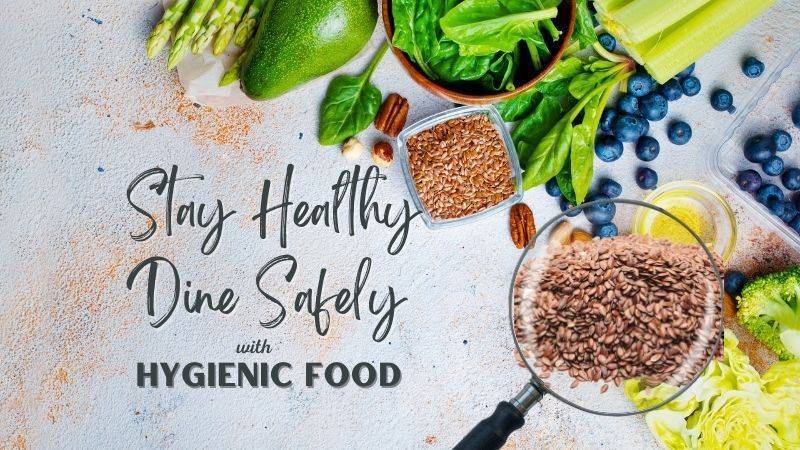“Stay healthy, dine safely – your ultimate guide to food, health, and hygiene.”
Outline
Food, health, and hygiene are three important aspects of life that are closely linked. Eating healthy, nutritious food is essential for maintaining good health, while practicing good hygiene helps to prevent the spread of disease.
Additionally, it is important to consider the environmental impact of our food choices and to strive for sustainability. By combining health, hygiene, and environmental responsibility, we can ensure that our food choices are beneficial for our health, our environment, and our communities.
Preparing and Cooking Safely
Cooking is an enjoyable activity that can be done safely with a few simple steps. Preparing and cooking food safely is essential to prevent foodborne illnesses.
The four fundamental steps to ensuring food safety at home are often referred to as the four C’s:
- Cleaning – Keep your hands, surfaces, and equipment/s clean before, during, and after cooking.
- Cooking – Properly cook food to eliminate harmful bacteria.
- Chilling – Store food at appropriate temperatures to inhibit the growth of detrimental bacteria.
- Avoiding cross-contamination – Prevent bacteria from spreading to surfaces and ready-to-eat food.
By sticking to these straightforward guidelines, you can confidently engage in safe cooking practices and minimize the likelihood of foodborne illnesses.
Cleaning
Harmful bacteria that can lead to foodborne illnesses may lurk in various areas of your kitchen. Ensuring thorough cleanliness of your hands, countertops, and cooking tools is crucial to prevent these bacteria from contaminating your meals.
Wash Your Hands

It is essential to properly wash your hands with soap and warm water at key times:
- Before preparing, cooking, or consuming food
- After handling raw ingredients like raw meat, uncooked eggs, and unwashed produce
- Following contact with the trash, using the restroom, sneezing, or touching pets
Proper handwashing technique is crucial for maintaining hygiene. To wash your hands effectively:
1. Wet your hands with warm water.
2. Apply soap and lather your hands for at least 20 seconds.
3. Scrub your hands, including the backs of your hands, between your fingers, and under your nails.
4. Rinse your hands with warm water.
5. Dry your hands with a clean towel or air dry them.
Clean Countertops and Dishcloths

Clean countertops, utensils, and cutting boards using warm, soapy water both before and after food preparation to inhibit the spread of bacteria. This step is particularly crucial when handling raw meat, raw eggs, or unwashed vegetables.
Whenever possible, use separate utensils and cutting boards for raw and ready-to-eat foods, or wash them meticulously between tasks.
For added protection, consider using a disinfectant to eliminate harmful bacteria. Follow the manufacturer’s instructions carefully, ensuring the disinfectant remains on the surface for the specified duration and diluting the product as needed before use.
Since damp and untidy dishcloths provide an ideal breeding ground for bacteria, it is essential to launder dishcloths and tea towels frequently, allowing them to dry completely before reusing them.
To ensure proper cleaning, wash dishcloths and tea towels using the hot cycle of your washing machine.
Cooking and reheating food
Cooking and reheating food can be a tricky process. It is important to understand the science behind it to ensure that food is cooked and reheated safely.
Cooking food
Ensure that the food reaches a safe internal temperature. This is especially important when cooking meat, poultry, and seafood. The internal temperature should be high enough to kill any bacteria that may be present.
To guarantee the safety of your food:
- Fully defrost meat before cooking, preferably in your refrigerator.
- Keep meat and ready-to-eat foods, like salads and bread, separate.
- Rotate and reposition food to ensure even cooking.
- Use distinct utensils for raw and cooked meats.
- Refrain from using a sauce or marinade for cooked food if it has been in contact with raw meat.
The USDA recommends that the internal temperature of cooked food should reach at least 145°F (63°C) for whole cuts of beef, pork, veal, and lamb, and at least 165°F (74°C) for poultry and ground meats.

Reheating food
Ensure that when reheating food, it reaches a steaming hot temperature and is heated thoroughly to 75°C (167°F).
Consume chilled food within two days of cooking. If the food has been cooked, frozen, and later defrosted, reheat it within 24 hours.
Reheat food only once, as repeatedly cooling and reheating increases the risk of foodborne illness.
It is also important to ensure that food is cooked and reheated evenly. This can be done by stirring the food occasionally and using a thermometer to check the internal temperature.
Storing and chilling food
When food is not stored and chilled correctly, bacteria can grow and cause food poisoning. To ensure food safety, it is important to understand the basics of storing and chilling food.
To maintain food safety:
- Set your fridge to the appropriate temperature range (between 0°C and 5°C, or 32°F and 41°F).
- Minimize the time food spends outside the fridge.
- Avoid overfilling your refrigerator.
- Consume leftovers within two days.
- Cool cooked food rapidly (ideally within 1 to 2 hours) before refrigerating – dividing cooked food into smaller portions can expedite cooling.

When storing food, it is important to keep it at the right temperature. Perishable food such as meat, poultry, fish, dairy, and eggs should be stored at 40°F or below.
Non-perishable food, such as canned goods, can be stored at room temperature.
Don’t forget to label and date food when storing it to keep track of when the food was stored and when it should be used.
When chilling food, cool it quickly by dividing large amounts of food into smaller portions and placing them in shallow containers. It is also important to chill food within two hours of cooking.
Avoiding cross-contamination

Cross-contamination is a serious issue in the food industry. It occurs when bacteria, viruses, or other microorganisms are transferred from one food item to another, for instance when raw food contacts or trickles onto cooked food varieties, utensils, or surfaces potentially causing foodborne illness.
To minimize the risk of foodborne illness, it’s important to follow these guidelines:
- Keep raw meat and unwashed vegetables separate from ready-to-eat foods during storage and preparation.
- Use different chopping boards, plates, and utensils for raw and cooked food, or wash them thoroughly between uses.
- Thoroughly wash your hands, work surfaces, and utensils after handling raw meat, poultry, fish, and eggs.
- Store raw meat in a sealed container at the bottom of the refrigerator.
- Never wash raw meat before cooking it.
- Use separate shopping bags for raw and ready-to-eat foods.
Cross-contamination can be avoided by following these simple steps. By practicing good hygiene and keeping raw and cooked foods separate, you can help ensure that your food is safe to eat.
Impact of Poor Hygiene on Health: How to Avoid Common Illnesses
Good hygiene is essential for maintaining good health where Poor hygiene can lead to a variety of illnesses, including skin infections, respiratory infections, and gastrointestinal illnesses.
Skin infections, such as impetigo and cellulitis, can be caused by poor hygiene practices, such as not washing hands after using the bathroom or not showering regularly.
Respiratory infections, such as the common cold and influenza, can be caused by not washing hands after touching contaminated surfaces or not covering the mouth and nose when sneezing or coughing.
Gastrointestinal illnesses, such as food poisoning, can be caused by not washing hands after handling the raw food or not washing food preparation surfaces.
To avoid common illnesses, it is important to practice good hygiene. This includes
- washing hands frequently with soap and water, especially after using the bathroom, before and after preparing food, and after touching contaminated surfaces.
- shower regularly
- cover the mouth and nose when sneezing or coughing.
- avoid sharing personal items, such as toothbrushes and towels
- avoid touching the face with unwashed hands.
By following these simple steps, you can help protect yourself and others from illness.
Also, Read
How to Reduce Stress with Food
How to Eat a Balanced Diet
Why is Protein Important in Your Diet
Varicose Veins Exercise






